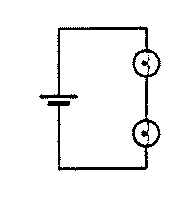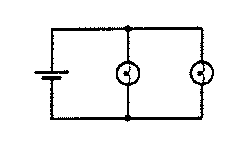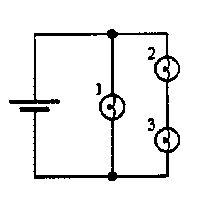| H. E. Smith | Spring 2000 |

| Physics 1B - Tutorial #7 |

You will be provided with light bulbs, batteries and clip wires. You should work in pairs where possible. Make sure each student makes each circuit. You may make your notes on this sheet or separate pages as you wish. Please leave the equipment in good condition for the next tutorial session.
 |
Starting with these assumptions, we will develop a model that we can use to account for the behaviour of simple circuits.
|
 |
|
Set up a two-bulb circuit with identical bulbs so that their terminals are
connected together as shown. Bulbs connected together in this way are said
to be connected in parallel.
|
 |
|

|
| |

|
|

|